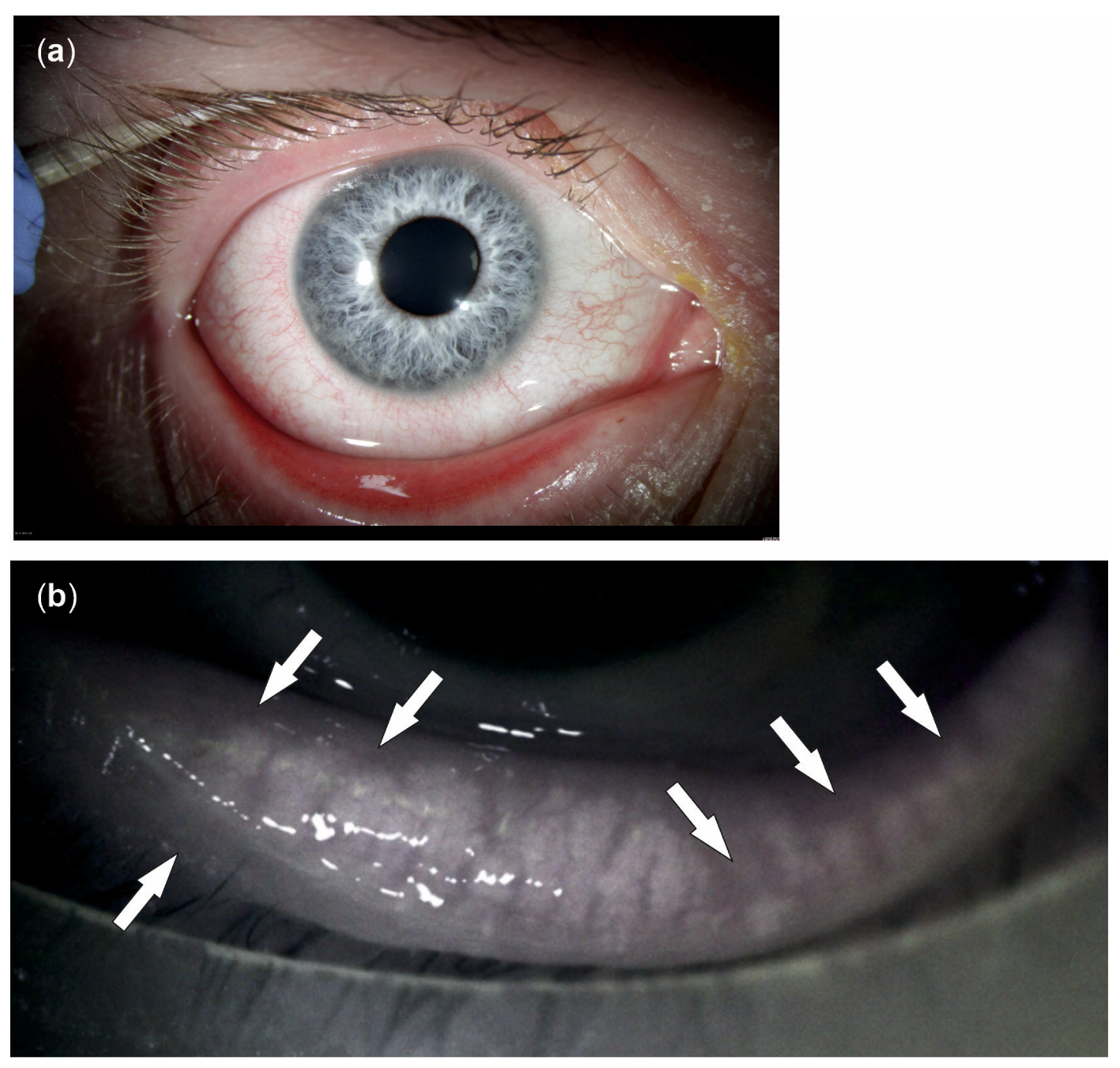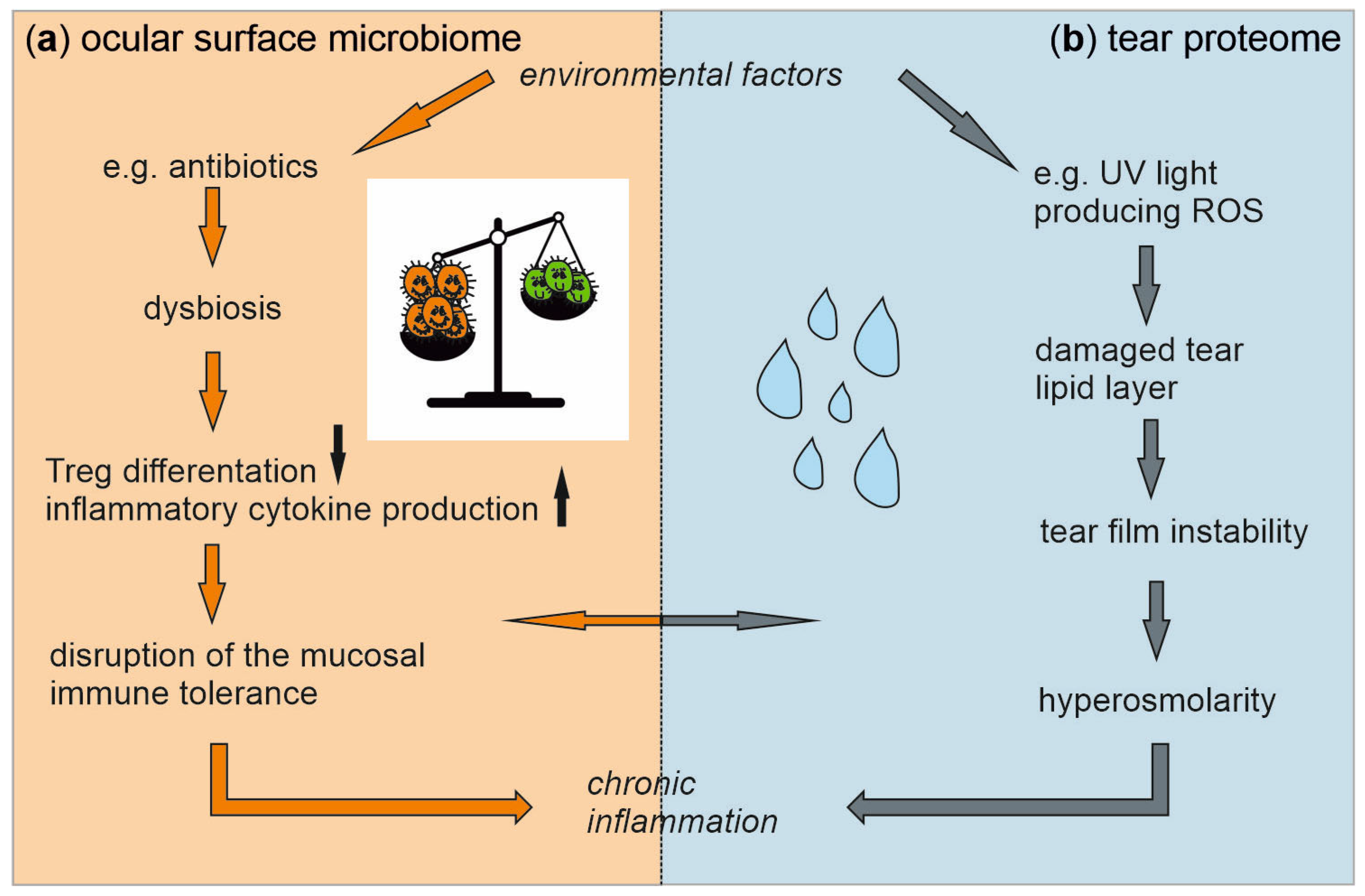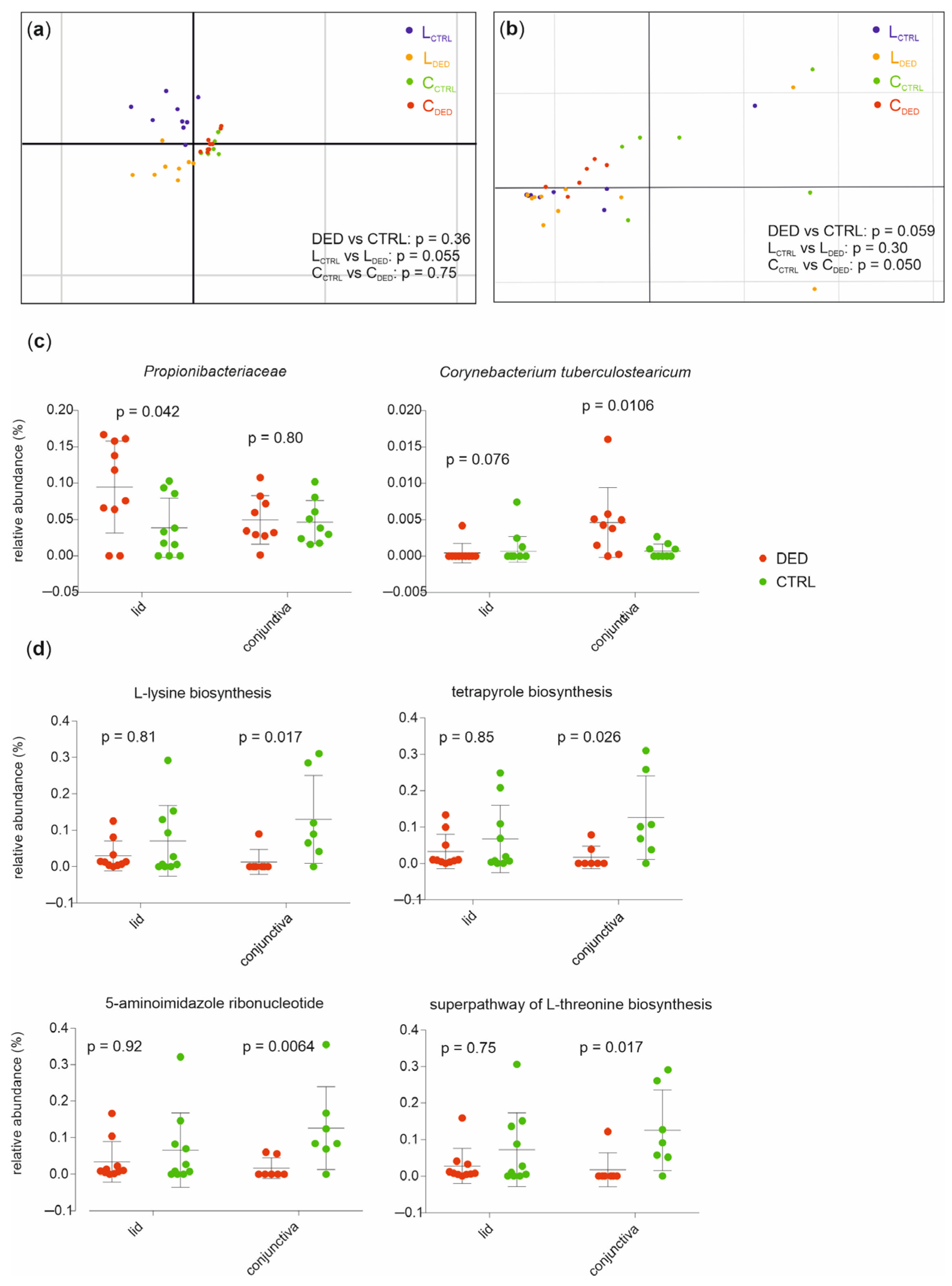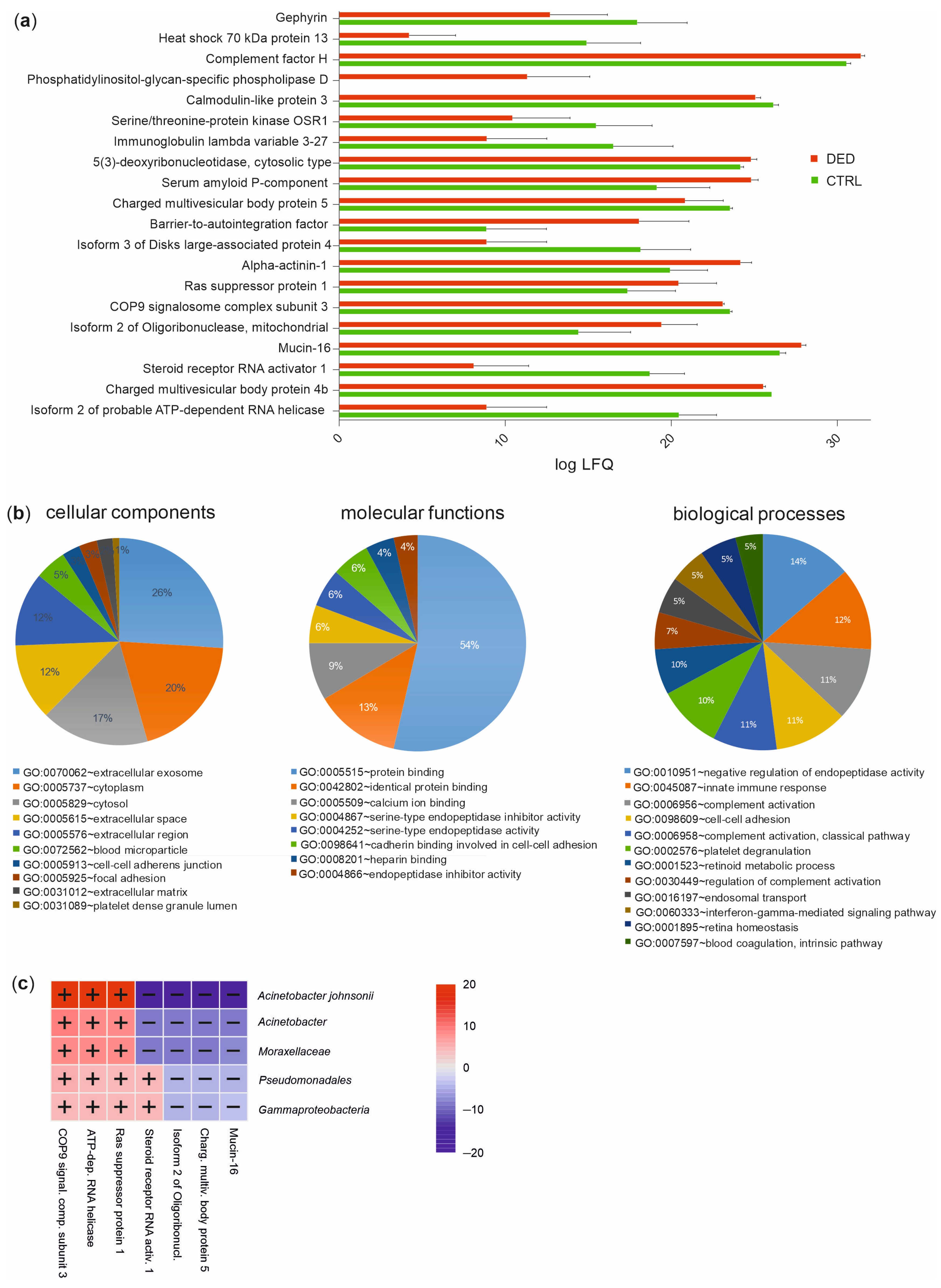The Human Ocular Surface Microbiome and Its Associations with the Tear Proteome in Dry Eye Disease
Abstract
:1. Introduction
2. Results
2.1. Demographic Data
2.2. Taxonomical and Functional Characterization of the Ocular Surface Microbiome in Dry Eye Disease
2.3. Associations between the Ocular Surface Microbiome and Clinical Metadata
2.4. Functional Classification of the Tear Proteome in Dry Eye Disease
3. Discussion
3.1. The Role of the Human Ocular Surface Microbiome in Dry Eye Disease
3.2. The Role of the Human Tear Proteome in Dry Eye Disease
3.3. Conclusions
4. Materials and Methods
4.1. Study Design and Recruitment
4.2. Assessment of Dry Eye Disease
4.3. Sample Collection
4.4. DNA Extraction and Metagenomics DNA Sequencing
4.5. Nano Liquid Chromatography–Tandem Mass Spectrometry (nLC-MS/MS)
4.6. Statistical Analysis
Author Contributions
Funding
Institutional Review Board Statement
Informed Consent Statement
Data Availability Statement
Conflicts of Interest
References
- Dana, R.; Bradley, J.L.; Guerin, A.; Pivneva, I.; Stillman, I.O.; Evans, A.M.; Schaumberg, D.A. Estimated Prevalence and Incidence of Dry Eye Disease Based on Coding Analysis of a Large, All-age United States Health Care System. Am. J. Ophthalmol. 2019, 202, 47–54. [Google Scholar] [CrossRef] [PubMed]
- Stapleton, F.; Alves, M.; Bunya, V.Y.; Jalbert, I.; Lekhanont, K.; Malet, F.; Na, K.S.; Schaumberg, D.; Uchino, M.; Vehof, J.; et al. TFOS DEWS II Epidemiology Report. Ocul. Surf. 2017, 15, 334–365. [Google Scholar] [CrossRef] [PubMed]
- Zhang, X.; Jeyalatha M., V.; Qu, Y.; He, X.; Ou, S.; Bu, J.; Jia, C.; Wang, J.; Wu, H.; Liu, Z.; et al. Dry Eye Management: Targeting the Ocular Surface Microenvironment. Int. J. Mol. Sci. 2017, 18, 1398. [Google Scholar] [CrossRef] [PubMed]
- Uchino, M.; Schaumberg, D.A. Dry Eye Disease: Impact on Quality of Life and Vision. Curr. Ophthalmol. Rep. 2013, 1, 51–57. [Google Scholar] [CrossRef]
- Craig, J.P.; Nichols, K.K.; Akpek, E.K.; Caffery, B.; Dua, H.S.; Joo, C.K.; Liu, Z.; Nelson, J.D.; Nichols, J.J.; Tsubota, K.; et al. TFOS DEWS II Definition and Classification Report. Ocul. Surf. 2017, 15, 276–283. [Google Scholar] [CrossRef] [PubMed]
- Galletti, J.G.; Guzman, M.; Giordano, M.N. Mucosal immune tolerance at the ocular surface in health and disease. Immunology 2017, 150, 397–407. [Google Scholar] [CrossRef]
- Zinkernagel, M.S.; Zysset-Burri, D.C.; Keller, I.; Berger, L.E.; Leichtle, A.B.; Largiader, C.R.; Fiedler, G.M.; Wolf, S. Association of the Intestinal Microbiome with the Development of Neovascular Age-Related Macular Degeneration. Sci. Rep. 2017, 7, 40826. [Google Scholar] [CrossRef]
- Zysset-Burri, D.C.; Keller, I.; Berger, L.E.; Largiader, C.R.; Wittwer, M.; Wolf, S.; Zinkernagel, M.S. Associations of the intestinal microbiome with the complement system in neovascular age-related macular degeneration. NPJ Genom. Med. 2020, 5, 34. [Google Scholar] [CrossRef]
- Zysset-Burri, D.C.; Keller, I.; Berger, L.E.; Neyer, P.J.; Steuer, C.; Wolf, S.; Zinkernagel, M.S. Retinal artery occlusion is associated with compositional and functional shifts in the gut microbiome and altered trimethylamine-N-oxide levels. Sci. Rep. 2019, 9, 15303. [Google Scholar] [CrossRef]
- Moon, J.; Choi, S.H.; Yoon, C.H.; Kim, M.K. Gut dysbiosis is prevailing in Sjogren’s syndrome and is related to dry eye severity. PLoS ONE 2020, 15, e0229029. [Google Scholar] [CrossRef]
- Napolitano, P.; Filippelli, M.; Davinelli, S.; Bartollino, S.; dell’Omo, R.; Costagliola, C. Influence of gut microbiota on eye diseases: An overview. Ann. Med. 2021, 53, 750–761. [Google Scholar] [CrossRef] [PubMed]
- Horai, R.; Caspi, R.R. Microbiome and Autoimmune Uveitis. Front. Immunol. 2019, 10, 232. [Google Scholar] [CrossRef] [PubMed]
- Li, Z.; Zhu, H.; Zhang, L.; Qin, C. The intestinal microbiome and Alzheimer’s disease: A review. Anim. Model. Exp. Med. 2018, 1, 180–188. [Google Scholar] [CrossRef] [PubMed]
- Opazo, M.C.; Ortega-Rocha, E.M.; Coronado-Arrazola, I.; Bonifaz, L.C.; Boudin, H.; Neunlist, M.; Bueno, S.M.; Kalergis, A.M.; Riedel, C.A. Intestinal Microbiota Influences Non-intestinal Related Autoimmune Diseases. Front. Microbiol. 2018, 9, 432. [Google Scholar] [CrossRef]
- Pascal, V.; Pozuelo, M.; Borruel, N.; Casellas, F.; Campos, D.; Santiago, A.; Martinez, X.; Varela, E.; Sarrabayrouse, G.; Machiels, K.; et al. A microbial signature for Crohn’s disease. Gut 2017, 66, 813–822. [Google Scholar] [CrossRef]
- Silverman, G.J. The microbiome in SLE pathogenesis. Nat. Rev. Rheumatol. 2019, 15, 72–74. [Google Scholar] [CrossRef]
- Zarate-Blades, C.R.; Horai, R.; Mattapallil, M.J.; Ajami, N.J.; Wong, M.; Petrosino, J.F.; Itoh, K.; Chan, C.C.; Caspi, R.R. Gut microbiota as a source of a surrogate antigen that triggers autoimmunity in an immune privileged site. Gut Microbes 2017, 8, 59–66. [Google Scholar] [CrossRef]
- Zysset-Burri, D.C.; Schlegel, I.; Lincke, J.B.; Jaggi, D.; Keller, I.; Heller, M.; Lagache, S.B.; Wolf, S.; Zinkernagel, M.S. Understanding the Interactions between the Ocular Surface Microbiome and the Tear Proteome. Investig. Ophthalmol. Vis. Sci. 2021, 62, 8. [Google Scholar] [CrossRef]
- Seen, S.; Tong, L. Dry eye disease and oxidative stress. Acta Ophthalmol. 2018, 96, e412–e420. [Google Scholar] [CrossRef]
- Heidari, M.; Noorizadeh, F.; Wu, K.; Inomata, T.; Mashaghi, A. Dry Eye Disease: Emerging Approaches to Disease Analysis and Therapy. J. Clin. Med. 2019, 8, 1439. [Google Scholar] [CrossRef]
- Huang da, W.; Sherman, B.T.; Lempicki, R.A. Bioinformatics enrichment tools: Paths toward the comprehensive functional analysis of large gene lists. Nucleic Acids Res. 2009, 37, 1–13. [Google Scholar] [CrossRef] [PubMed]
- Huang, Y.; Yang, B.; Li, W. Defining the normal core microbiome of conjunctival microbial communities. Clin. Microbiol. Infect. 2016, 22, 643.e7–643.e12. [Google Scholar] [CrossRef] [PubMed]
- Stern, M.E.; Schaumburg, C.S.; Pflugfelder, S.C. Dry eye as a mucosal autoimmune disease. Int. Rev. Immunol. 2013, 32, 19–41. [Google Scholar] [CrossRef]
- Feurer, C.; Clermont, D.; Bimet, F.; Candrea, A.; Jackson, M.; Glaser, P.; Bizet, C.; Dauga, C. Taxonomic characterization of nine strains isolated from clinical and environmental specimens, and proposal of Corynebacterium tuberculostearicum sp. nov. Int. J. Syst. Evol. Microbiol. 2004, 54 (Pt 4), 1055–1061. [Google Scholar] [CrossRef]
- Altonsy, M.O.; Kurwa, H.A.; Lauzon, G.J.; Amrein, M.; Gerber, A.N.; Almishri, W.; Mydlarski, P.R. Corynebacterium tuberculostearicum, a human skin colonizer, induces the canonical nuclear factor-kappaB inflammatory signaling pathway in human skin cells. Immun. Inflamm. Dis. 2020, 8, 62–79. [Google Scholar] [CrossRef]
- Jovel, J.; Patterson, J.; Wang, W.; Hotte, N.; O’Keefe, S.; Mitchel, T.; Perry, T.; Kao, D.; Mason, A.L.; Madsen, K.L.; et al. Characterization of the Gut Microbiome Using 16S or Shotgun Metagenomics. Front. Microbiol. 2016, 7, 459. [Google Scholar] [CrossRef]
- Pedrazini, M.C.; da Silva, M.H.; Groppo, F.C. L-lysine: Its antagonism with L-arginine in controlling viral infection. Narrative literature review. Br. J. Clin. Pharmacol. 2022, 88, 4708–4723. [Google Scholar] [CrossRef]
- Tong, L.; Li, J.; Chew, J.; Tan, D.; Beuerman, R. Phospholipase D in the Human Ocular Surface and in Pterygium. Cornea 2008, 27, 693–698. [Google Scholar] [CrossRef] [PubMed]
- Blalock, T.D.; Spurr-Michaud, S.J.; Tisdale, A.S.; Heimer, S.R.; Gilmore, M.S.; Ramesh, V.; Gipson, I.K. Functions of MUC16 in corneal epithelial cells. Investig. Ophthalmol. Vis. Sci. 2007, 48, 4509–4518. [Google Scholar] [CrossRef] [PubMed]
- Paulsen, F.; Jager, K.; Worlitzsch, D.; Brauer, L.; Schulze, U.; Schafer, G.; Sel, S. Regulation of MUC16 by inflammatory mediators in ocular surface epithelial cell lines. Ann. Anat. 2008, 190, 59–70. [Google Scholar] [CrossRef]
- Blalock, T.D.; Spurr-Michaud, S.J.; Tisdale, A.S.; Gipson, I.K. Release of membrane-associated mucins from ocular surface epithelia. Investig. Ophthalmol. Vis. Sci. 2008, 49, 1864–1871. [Google Scholar] [CrossRef] [PubMed]
- Liebscher, M.; Jahreis, G.; Lucke, C.; Grabley, S.; Raina, S.; Schiene-Fischer, C. Fatty acyl benzamido antibacterials based on inhibition of DnaK-catalyzed protein folding. J. Biol. Chem. 2007, 282, 4437–4446. [Google Scholar] [CrossRef]
- Sedlacek, V.; Kryl, M.; Kucera, I. The ArsH Protein Product of the Paracoccus denitrificans ars Operon Has an Activity of Organoarsenic Reductase and Is Regulated by a Redox-Responsive Repressor. Antioxid 2022, 11, 902. [Google Scholar] [CrossRef]
- Strycharska, M.S.; Arias-Palomo, E.; Lyubimov, A.Y.; Erzberger, J.P.; O’Shea, V.L.; Bustamante, C.J.; Berger, J.M. Nucleotide and partner-protein control of bacterial replicative helicase structure and function. Mol. Cell 2013, 52, 844–854. [Google Scholar] [CrossRef]
- Soultanas, P. The bacterial helicase-primase interaction: A common structural/functional module. Structure 2005, 13, 839–844. [Google Scholar] [CrossRef]
- Elhusseiny, A.M.; Khalil, A.A.; El Sheikh, R.H.; Bakr, M.A.; Eissa, M.G.; El Sayed, Y.M. New approaches for diagnosis of dry eye disease. Int. J. Ophthalmol. 2019, 12, 1618–1628. [Google Scholar] [CrossRef] [PubMed]
- Sullivan, B.D.; Crews, L.A.; Messmer, E.M.; Foulks, G.N.; Nichols, K.K.; Baenninger, P.; Geerling, G.; Figueiredo, F.; Lemp, M.A. Correlations between commonly used objective signs and symptoms for the diagnosis of dry eye disease: Clinical implications. Acta Ophthalmol. 2014, 92, 161–166. [Google Scholar] [CrossRef]
- van Setten, G.; Labetoulle, M.; Baudouin, C.; Rolando, M. Evidence of seasonality and effects of psychrometry in dry eye disease. Acta Ophthalmol. 2016, 94, 499–506. [Google Scholar] [CrossRef]
- Ward, C.D.; Murchison, C.E.; Petroll, W.M.; Robertson, D.M. Evaluation of the Repeatability of the LacryDiag Ocular Surface Analyzer for Assessment of the Meibomian Glands and Tear Film. Transl. Vis. Sci. Technol. 2021, 10, 1. [Google Scholar] [CrossRef] [PubMed]
- Bolger, A.M.; Lohse, M.; Usadel, B. Trimmomatic: A flexible trimmer for Illumina sequence data. Bioinformatics 2014, 30, 2114–2120. [Google Scholar] [CrossRef]
- Langmead, B.; Salzberg, S.L. Fast gapped-read alignment with Bowtie 2. Nat. Methods 2012, 9, 357–359. [Google Scholar] [CrossRef]
- Segata, N.; Waldron, L.; Ballarini, A.; Narasimhan, V.; Jousson, O.; Huttenhower, C. Metagenomic microbial community profiling using unique clade-specific marker genes. Nat. Methods 2012, 9, 811–814. [Google Scholar] [CrossRef] [PubMed]
- The Human Microbiome Project Consortium. A framework for human microbiome research. Nature 2012, 486, 215–221. [Google Scholar] [CrossRef] [PubMed]
- Abubucker, S.; Segata, N.; Goll, J.; Schubert, A.M.; Izard, J.; Cantarel, B.L.; Rodriguez-Mueller, B.; Zucker, J.; Thiagarajan, M.; Henrissat, B.; et al. Metabolic reconstruction for metagenomic data and its application to the human microbiome. PLoS Comput. Biol. 2012, 8, e1002358. [Google Scholar] [CrossRef]
- Cox, J.; Mann, M. Maxquant Enables High Peptide Identification Rates, Individualized P.P.B.-Range Mass Accuracies and Proteome-Wide Protein Quantification. Nat. Biotechnol. 2008, 26, 1367–1372. [Google Scholar] [CrossRef] [PubMed]
- Dray, S.; Dufour, A.B. The ade4 Package: Implementing the Duality Diagram for Ecologists. J. Stat. Softw. 2007, 22, 1–20. [Google Scholar] [CrossRef]
- Anderson, M.J. A new method for non-parametric multivariate analysis of variance. Austral Ecol. 2001, 26, 32–46. [Google Scholar]
- Morgan, X.C.; Tickle, T.L.; Sokol, H.; Gevers, D.; Devaney, K.L.; Ward, D.V.; Reyes, J.A.; Shah, S.A.; LeLeiko, N.; Snapper, S.B.; et al. Dysfunction of the intestinal microbiome in inflammatory bowel disease and treatment. Genome Biol. 2012, 13, R79. [Google Scholar] [CrossRef]





| Feature | DED (n = 10) | CTRL (n = 10) | p Value DED vs. CTRL |
|---|---|---|---|
| Males (n) | 7 | 8 | 1.0 1 |
| Age (years) | 69.6 ± 11.3 | 69.7 ± 4.2 | 1.0 2 |
| OSDI© score | 13.8 ± 12.4 | 7.8 ± 7.7 | 0.2 2 |
| Osmolarity (mOsmol/L) | 306.3 ± 30.4 | 298.8 ± 15.0 | 0.5 2 |
| Slit lamp score | 17.6 ± 1.6 | 2.9 ± 1.9 | <0.0001 2 |
| Schirmer’s test ll (mm) | 14.4 ± 7.0 | 16.7 ± 6.0 | 0.4 2 |
| Osmolarity (mOsmol/L) | L-arginine Biosynthesis (%) |
|---|---|
| 267 | 0 |
| 286 | 0 |
| 288 | 0 |
| 288 | 0 |
| 289 | 1.58 |
| 289 | 0 |
| 295 | 0 |
| 297 | 0 |
| 300 | 0 |
| 305 | 0 |
| 312 | 0 |
| 335 | 1.76 |
| 354 | 1.62 |
| 365 | 1.56 |
| Taxonomy | Protein | Nb. of Samples |
|---|---|---|
| Acinetobacter johnsonii | Arsenical resistance protein ArsH | 18 |
| Acinetobacter sp. | DNA-binding response regulator | 2 |
| Agrobacterium radiobacter | Polyribonucleotide nucleotidyltransferase | 2 |
| Agrobacterium radiobacter | Molybdopterin biosynthesis protein | 1 |
| Agrobacterium sp. | Chaperone protein DnaK | 19 |
| Agrobacterium sp. | Anthranilate synthase | 8 |
| Agrobacterium sp. | Uncharacterized protein | 3 |
| Agrobacterium sp. | Phage tail protein | 1 |
| Agrobacterium sp. | Membrane fusion protein (MFP) | 7 |
| Agrobacterium sp. | DEAD/DEAH box helicase | 8 |
| Campylobacter ureolyticus | Cytochrome c biogenesis protein | 4 |
| Corynebacterium accolens | Bifunctional RNase H/acid phosphatase | 15 |
| Cutibacterium acnes | Helicase | 17 |
| Cutibacterium acnes | Ribonuclease Y | 10 |
Disclaimer/Publisher’s Note: The statements, opinions and data contained in all publications are solely those of the individual author(s) and contributor(s) and not of MDPI and/or the editor(s). MDPI and/or the editor(s) disclaim responsibility for any injury to people or property resulting from any ideas, methods, instructions or products referred to in the content. |
© 2023 by the authors. Licensee MDPI, Basel, Switzerland. This article is an open access article distributed under the terms and conditions of the Creative Commons Attribution (CC BY) license (https://creativecommons.org/licenses/by/4.0/).
Share and Cite
Schlegel, I.; De Goüyon Matignon de Pontourade, C.M.F.; Lincke, J.-B.; Keller, I.; Zinkernagel, M.S.; Zysset-Burri, D.C. The Human Ocular Surface Microbiome and Its Associations with the Tear Proteome in Dry Eye Disease. Int. J. Mol. Sci. 2023, 24, 14091. https://doi.org/10.3390/ijms241814091
Schlegel I, De Goüyon Matignon de Pontourade CMF, Lincke J-B, Keller I, Zinkernagel MS, Zysset-Burri DC. The Human Ocular Surface Microbiome and Its Associations with the Tear Proteome in Dry Eye Disease. International Journal of Molecular Sciences. 2023; 24(18):14091. https://doi.org/10.3390/ijms241814091
Chicago/Turabian StyleSchlegel, Irina, Claire M. F. De Goüyon Matignon de Pontourade, Joel-Benjamin Lincke, Irene Keller, Martin S. Zinkernagel, and Denise C. Zysset-Burri. 2023. "The Human Ocular Surface Microbiome and Its Associations with the Tear Proteome in Dry Eye Disease" International Journal of Molecular Sciences 24, no. 18: 14091. https://doi.org/10.3390/ijms241814091
APA StyleSchlegel, I., De Goüyon Matignon de Pontourade, C. M. F., Lincke, J. -B., Keller, I., Zinkernagel, M. S., & Zysset-Burri, D. C. (2023). The Human Ocular Surface Microbiome and Its Associations with the Tear Proteome in Dry Eye Disease. International Journal of Molecular Sciences, 24(18), 14091. https://doi.org/10.3390/ijms241814091







